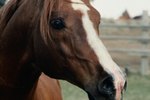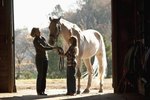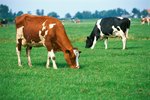
Wild horses have populated the American West for several hundred years. The populations today are descended from horses brought to North America by early Spanish explorers. While many wild horses live and die without ever experiencing captivity or being cared for by a human, finding food is a challenge that these animals have always faced.
Wild Horse Nutrition
In theory, wild horses survive by roaming large areas of land and grazing on whatever plant life is readily available and adequately nutritious. Horses are herbivores that can survive on a steady supply of healthy grass, shrubs and general plant life. The University of Connecticut estimates that horses graze for 15 to 17 hours a day if left in an environment where there is ample foliage for grazing. These hours of quality grazing provide a wild horse with all of the nutrition he needs to survive and thrive.
Wild Horse Habitat
Wild horses can find food by sight and smell. In the winter, horses will paw through snow to locate edible vegetation. Wild horse herds tend to stay in areas where water is readily available, although they do travel as they forage. It's not uncommon for a wild herd to travel several miles a day as the horses graze and roam across the range. Due to the limited amount of space available to America's wild horse herds, they tend to travel back and forth throughout the same general regions, establishing a general home range area.
Wild Horses in a Modern World
Today's wild horses face challenges that their ancestors did not. Wild horses aren't free to roam throughout the United States; instead, these animals have a limited grazing range that is controlled by the government. Horses also must share their range with livestock and other wild animals, such as deer and antelope. The situation is less than ideal for a continually growing wild horse population that needs a significant amount of daily forage to stay healthy.
Overpopulation
Many of the wild horse's natural predators have been eradicated. The Bureau of Land Management, a government agency charged with maintaining America's wild herds, estimates that thousands of new foals are born into those herds every year. The high birth rate of wild horses combined with few predators has led to an overpopulation in today's herds, translating to a shortage of available grazing areas. The BLM rounds up thousands of horses off the range each year and attempts to adopt them out to private owners as a means to prevent overpopulation and maintain adequate food supplies for the animals that remain in the wild.
Holding Facilities
As of 2013, the BLM has approximately 50,000 wild horses in holding facilities across the U.S. These horses have not found homes within the domestic horse population, but they've been removed from the wild in hopes of preserving the food supply for animals still on the range. The BLM spends millions feeding their captive herds every year, while the population in the wild continues to grow. In March 2013, Fox News reported that there are more wild horses being kept in captivity and cared for by the BLM than there are in the wild.
References
- Return to Freedom: About Wild Horses
- Fox News: American West Running Out of Room for Wild Horses, Officials Weigh Options
- Bureau of Land Management: Pryor Mountain Wild Horse Range
- New York Times: Wild Horses Are Running Out of Room, On and Off Range
- University of Connecticut: Pasture: Evaluation and Management of Existing Pasture
- High Country News: Wild horses Do they belong in the West?
- D.B. Young: Wild Horses of the High Desert
Photo Credits
-
Jupiterimages/Photos.com/Getty Images
Writer Bio
Jen Davis has been writing since 2004. She has served as a newspaper reporter and her freelance articles have appeared in magazines such as "Horses Incorporated," "The Paisley Pony" and "Alabama Living." Davis earned her Bachelor of Arts in communication with a concentration in journalism from Berry College in Rome, Ga.




